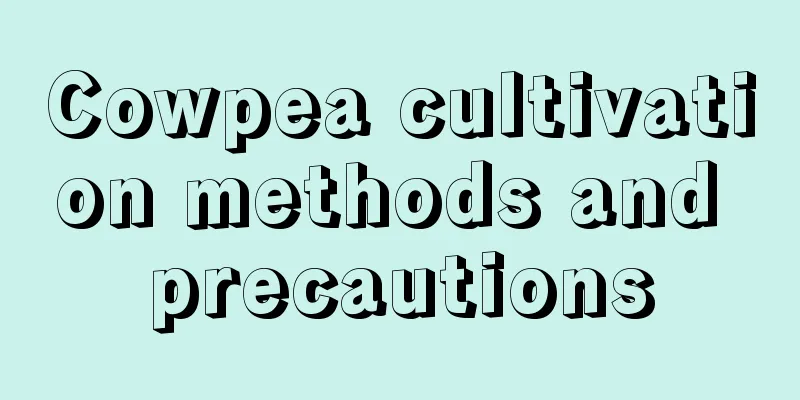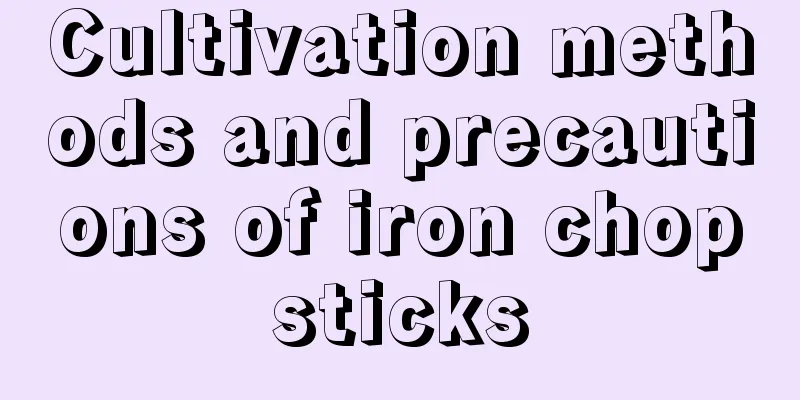Cowpea cultivation methods and precautions

1. Maintenance methods1. Soil: It needs a lot of nutrients to grow, so you must use relatively fertile soil. Its roots are not tolerant to waterlogging. In addition to being fertile, the air permeability of the soil must also be considered so that the accumulated water in the soil can be removed. 2. Watering: It needs to be watered sufficiently when everyone starts planting. The next time to water is after it blooms. If the flower is too dry during the growth period, it needs to be watered manually once a week. When watering, you must follow the principle of "watering the pods but not the flowers", because its flowers will fall off when they come into contact with water, which is not conducive to the growth of the plant. 3. Fertilization: In addition to the base fertilizer used in the soil before planting, it needs to be fertilized again every month. When it grows, it has relatively high requirements for phosphorus and potassium fertilizers. Therefore, when fertilizing, you should use fertilizers with relatively high phosphorus and potassium content. In addition to root fertilizers, you also need to use foliar fertilizers. This is because it will show symptoms of trace element deficiency in its subsequent growth, such as yellow leaves, etc. So in order to prevent this situation, you need to spray foliar fertilizers on it during the seedling stage. 4. Light: Although it is a short-day plant, many varieties are medium-light-tolerant, so the light requirements are not strict. 2. Breeding techniques1. Reproduction: It can be propagated by sowing. Its seeds are relatively large. Before sowing, they need to be soaked in cooled boiled water for 48 hours and then sown into the soil. After sowing, cover with soil and water sufficiently, and seedlings will emerge in about a week. 2. Pruning: Newly grown seedlings need to be topped off to promote the growth of side branches. 3. Problem Diagnosis1. Pests: It is easily infected by borers. Before pods form, you need to spray it with chlorothalonil as a preventive measure. If it is unfortunately still infected, you need to use insecticides to kill the insects. It should be noted that pesticides are toxic, and the pods cannot be picked for the time being after spraying. You must wait at least one to ten days before picking them. 2. Yellow leaves: Yellow leaves on the plant may be caused by insufficient nutrients. You need to increase the nutrition and fertilization frequency. IV. Other issues1. Edibility: It is edible. 2. Toxicity: Unfried pods are poisonous and can easily cause diarrhea. Therefore, when eating, it must be cooked thoroughly before eating. |
<<: Cultivation methods and precautions of rowan
>>: Cultivation methods and precautions of wolfsbane
Recommend
How to grow woody hydrangea
1. Soil Woody hydrangeas do not have strict requi...
What are the cultivation methods and precautions of lotus?
Lotus cultivation method Lotus is the common name...
Cockscomb cultivation methods and precautions
Cockscomb cultivation method soil Cockscomb is no...
How to care for newly bought spring feathers
1. Watering: Spring fern likes moisture and requi...
How to remedy cactus root rot
1. Remedies Take the cactus out of the pot and cu...
Where is the best place to plant camphor trees? Is it suitable to plant them at home?
Camphor tree planting area Camphor trees are suit...
What are the methods for sowing plum blossom seeds? How long does it take for plum blossom seeds to germinate?
1. Sowing method 1. Sowing time: Plum blossoms ar...
6 kinds of flowers that you should never grow at home
1. Poinsettia The whole plant is bright red, and ...
Can old rice be used as fertilizer?
Old rice as fertilizer Generally, old rice can be...
How to prune camellia bonsai? Pruning methods and techniques illustrated
Camellia bonsai pruning time No matter which meth...
What flowers are suitable for the elderly?
honeysuckle Honeysuckle can be made into a small ...
Can Yifanfengshun be propagated by cuttings? A method of rapid rooting and survival of cuttings
Can the plant "Smooth Sailing" be propa...
Can Auricularia auricula be propagated by cuttings?
The propagation of Auricularia auricula is genera...
Cultivation methods and precautions for bonsai banyan trees
1. Breeding methods 1. Loose soil: Banyan trees g...
When does osmanthus bloom?
1. Flowering time The flowering time of osmanthus...









